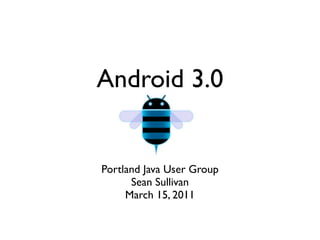
Android 3.0 Features and Tablet Development
- 1. Android 3.0 Portland Java User Group Sean Sullivan March 15, 2011
- 2. • Introduction • Android devices • Android 3.0 • App development
- 6. Mobile World Congress February 2011
- 10. Android phones
- 11. 2008
- 12. 2009
- 13. 2010
- 14. 2011
- 15. Android tablets
- 23. XOOM tech specs • Android 3.0 • 10.1 inch touchscreen display • 1280 x 800 • 160 dpi
- 24. XOOM tech specs • NVIDIA Tegra 2 dual-core chipset • HDMI connector • two cameras • no physical keyboard
- 28. What’s new in Android 3.0?
- 30. • ‘holographic’ UI theme • Action Bar • Fragments • Drag and Drop • Digital Rights Management • and more...
- 31. ‘holographic’ UI
- 33. Action Bar
- 34. “The Action Bar is a widget for activities that replaces the traditional title bar at the top of the screen. By default, the Action Bar includes the application logo on the left side, followed by the activity title, and any available items from the Options Menu on the right side.”
- 35. Action Bar
- 38. Fragments
- 39. “A Fragment represents a behavior or a portion of user interface in an Activity. You can combine multiple fragments in a single activity to build a multi-pane UI and reuse a fragment in multiple activities.You can think of a fragment as a modular section of an activity, which has its own lifecycle, receives its own input events, and which you can add or remove while the activity is running.” http://developer.android.com/guide/topics/fundamentals/fragments.html
- 40. • Fragments decompose application functionality and UI into reusable modules • Add multiple fragments to a screen to avoid switching activities • Fragments have their own lifecycle, state, and back stack • Fragments require API Level "Honeycomb" or greater http://developer.android.com/guide/topics/fundamentals/fragments.html
- 41. <LinearLayout xmlns:android="http://schemas.android.com/apk/res/android" android:orientation="horizontal" android:layout_width="match_parent" android:layout_height="match_parent"> <fragment class="com.example.android.apis.app.TitlesFragment" android:id="@+id/titles" android:layout_weight="1" android:layout_width="0px" android:layout_height="match_parent" /> <FrameLayout android:id="@+id/details" android:layout_weight="1" android:layout_width="0px" android:layout_height="match_parent" /> </LinearLayout>
- 42. public static class TitlesFragment extends ListFragment { private boolean mDualPane; private int mCurCheckPosition = 0; @Override public void onActivityCreated(Bundle savedState) { super.onActivityCreated(savedState); // do something here } @Override public void onSaveInstanceState(Bundle outState) { super.onSaveInstanceState(outState); outState.putInt("curChoice", mCurCheckPosition); } @Override public void onListItemClick(ListView l, View v, int pos, long id) { // do something here } }
- 45. Drag and drop
- 48. Renderscript
- 49. “The Renderscript rendering and computational APIs offer a low-level, high performance means of carrying out mathematical calculations and 3D graphics rendering.”
- 53. Digital Rights Management API
- 56. The same security issues that have led to piracy concerns on the Android platform have made it difficult for us to secure a common Digital Rights Management (DRM) system on these devices. [...] Although we don’t have a common platform security mechanism and DRM, we are able to work with individual handset manufacturers to add content protection to their devices. November 2010 http://blog.netflix.com/2010/11/netflix-on-android.html
- 57. Unfortunately, this is a much slower approach and leads to a fragmented experience on Android, in which some handsets will have access to Netflix and others won’t. We will also continue to work with the Android community, handset manufacturers, carriers, and other service providers to develop a standard, platform-wide solution that allows content providers to deliver their services to all Android-based devices November 2010 http://blog.netflix.com/2010/11/netflix-on-android.html
- 61. Android emulator
- 64. About emulator performance Because the Android emulator must simulate the ARM instruction set on your computer and the WXGA screen is significantly larger than a typical virtual device, emulator performance is much slower than a real device. source: developer.android.com
- 65. In particular, initializing the emulator can be slow and can take several minutes, depending on your hardware. When the emulator is booting, there is limited user feedback, so please be patient and wait until you see the home screen (or lock screen) appear. source: developer.android.com
- 66. However, you don't need to boot the emulator each time you rebuild your application—typically you only need to boot at the start of a session and keep it running. Also see the tip below for information about using a snapshot to drastically reduce startup time after the first initialization. We're working hard to resolve the performance issues and it will improve in future tools releases. source: developer.android.com
- 78. Sample code
- 81. API differences
- 84. Best practices
- 88. What’s next?
- 91. Final thoughts • Android 3.0 is for tablets, not phones • XOOM is available now • Additional Honeycomb tablets coming soon • Learn the Fragments API
- 92. Thank you
